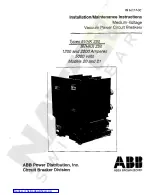
3VA molded case circuit breakers with IEC certificate
Manual, 03/2019, A5E03603177010-03
661
Glossary
AUTO
Method of remote operation of the motor operators via control cables, e.g. PLC.
Breaking capacity
The breaking capacity is the rms value of the current at a specific cos
φ (power factor) and a
specific voltage which can be safely interrupted by a switching device or fuse under
prescribed conditions. The rms value of the symmetrical component applies in the case of
alternating current.
I
2
t characteristic
The
I
2
t characteristic is a curve which represents the minimum or maximum values of
I
2
t in
relation to break times as a function of the prospective current under defined operating
conditions.
I
2
t value
The
I
2
t value is the thermal value of a prospective or a limited short-circuit current (let-
through current).
Let-through current
The let-through current
I
D
is the maximum instantaneous current value during the breaking
time of a switching device or fuse. Limited short-circuit currents occur if the switching device
reduces the amplitude of the short-circuit current due to, for example, resistance, switching
delay and peak arc voltage. The let-through current of a device such as a current-limiting
fuse or a current-limiting molded case circuit breaker determines the thermal load (
I
2
t value)
imposed on equipment connected downstream of the device (current limiting).
LOCK
Operating mode of motor operators; the operating mechanism is locked and cannot be
operated.
Making capacity
The making capacity is the value of the prospective making current which the switching
device can safely conduct at the instant of closing under prescribed conditions for a specific
circuit.












































